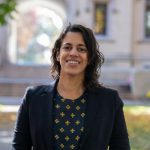
Wooster students identify new rainwater contaminants and earn mention in prestigious chemistry magazine

Chemical & Engineering News (C&EN)—the world’s premiere weekly magazine covering news in chemistry and related fields—recently featured a publication from a team of students and professors at The College of Wooster among the 2022 research trends for persistent pollutants.
The student-led team includes Yubin Kim ’24, Kyndalanne Pike ’20, Jameson Sprankle ’24; Rebekah Gray, Ph.D., postdoctoral scholar; Paul Edmiston, Theron L. Peterson and Dorothy R. Peterson Professor of Chemistry, Biochemistry and Molecular Biology; and, Jennifer Faust, assistant professor of chemistry.
The groundbreaking work was initially published in the journal Environmental Science: Processes & Impacts in November 2022 where the team identified pollutants known as per- and polyfluoroalkyl substances (PFAS) in rainwater from the central U.S. These contaminants, often called “forever chemicals,” are used for food packaging, waterproof coatings, and as flame retardants. Their applications have led to PFAS leaking into the environment, where they don’t degrade.
“Wooster students were involved at every step of the project, from planning measurements, to conducting lab work, to analyzing and interpreting data, to publishing the manuscript,” said Faust. “I was proud of our students and glad to see their research receive national attention.”
She explained that the research started with Kyndalanne Pike’s Independent Study that detected PFAS in rainwater samples collected at seven sites during the summer of 2019. “PFAS are a concern because of their ubiquity, persistence, and toxicity,” added Faust. In fact, PFAS have been linked to several serious health issues including cancer and neurodegenerative diseases in children.
After Pike’s I.S., the project grew in new directions thanks to the acquisition of a high-resolution mass spectrometer funded through a National Science Foundation Major Research Instrumentation grant. During summer research in 2022, Kim identified many PFAS that had never before been detected in rainwater, and Sprankle performed air mass modeling to gain insight into PFAS sources.
“The U.S. Environmental Protection Agency (EPA) has been monitoring PFAS, however, the number of identified compounds represents only a few PFAS since it can change its molecular features through thermal transformation,” said Kim, who led the project. “My job was to identify the name, structure, and concentration of the chemical that has not been monitored by the EPA,” explained Kim.
Kim, a third-year chemistry major, said she learned a lot about empirical science and gained a lot of confidence in doing scientific analysis. She also uncovered an interest in analytical chemistry and research she didn’t realize she had.
“Kim’s work is really at the cutting edge of modern research in environmental chemistry, so there was little precedent for the analysis methods she developed,” said Faust, who underscored the value of research opportunities at the undergraduate level. “It is relatively rare for undergraduate students like Kyndalanne, Yubin, and Jameson to have such deep ownership of research at the forefront of their field.”
Pike went on to the University of Wisconsin-Madison to pursue a Ph.D. in analytical chemistry. Kim presented her research at the annual Society of Environmental Toxicology and Chemistry (SETAC) North America meeting last fall alongside another of Edmiston’s research students who also works on PFAS. Sprankle is already a co-author on two publications in peer-reviewed journals. He is now an expert in HYSPLIT, a model from the National Oceanic and Atmospheric Administration that he uses to identify the origins of air masses prior to rainfall events.
“My advisor, ‘Dr. E’ and the professors I collaborated with were great listeners. They respected my opinions rather than giving me a set of to-do lists,” said Kim, who plans to continue this work for her own senior I.S. Edmiston will continue advising research students who are measuring PFAS in rainwater, soil, and sediments in the local region. Faust is collaborating with Andy May, associate professor of civil environmental and geodetic engineering at The Ohio State University, and Shubham Vyas, associate professor of chemistry at Colorado School of Mines, to explore PFAS transport and fate in the atmosphere.
Image: Yubin Kim ’24 led the chemistry study recognized by Chemical & Engineering News among research trends in 2022 , here with Wooster’s advanced mass spectrometer, an instrument that allows researchers to study the makeup of rainwater samples.
Posted in News on February 3, 2023.
Related Posts
Related Areas of Study
Chemistry
Access to labs, research opportunities, and small classes give chemistry majors lots of options after graduation.
Major Minor

